This month Gennaro Gattuso followed in the footsteps of compatriots Claudio Ranieri and Cesare Prandelli and became the third Italian manager to take charge of Valencia. C.F.
The former Napoli boss has signed a two-year deal to become owner Peter Lims tenth managerial appointment since buying the club in 2014. He has replaced Jose Bordalas who was sacked after the club finished ninth in La Liga last season.
The journeyman manager has proven to be an unpopular choice amongst Valencia fans, who have now added to their protests of the club’s ownership by picking up the baton from Tottenham’s supporters last season and started protesting against Gattuso’s appointment.
This article will be a tactical analysis of Gennaro Gattuso’s tactics and style of play. We will focus on his time at Napoli and provide an insight into the tactical trends the Valencia fans can expect to see at the Mestalla this coming season.
Data Analysis
Tactically there will be similarities between how Valencia set up under Jose Bordalas and how they set up under Gennaro Gattuso. As we will show in this analysis, out of possession there are similar principles that are applied in Gattuso’s and Bordalas’s defensive shape. However, the way Gattuso wants his team to regain the ball differs from what Valencia will have seen at the Mestalla last season.
During Gattuso’s full season in charge of Napoli, their opposition averaged 13.81 passes per defensive action before Napoli started to engage in winning the ball back, with their challenge intensity measuring at 5.1. This is how many defensive duels, loose ball duels, interceptions and tackles Napoli were performing for each of their opponent’s possessions.
The table below shows how they compared to the other teams in Serie A during the 2021/22 season. As you can see Napoli ranked low with their challenge intensity and was only the 10th highest for PPDA.
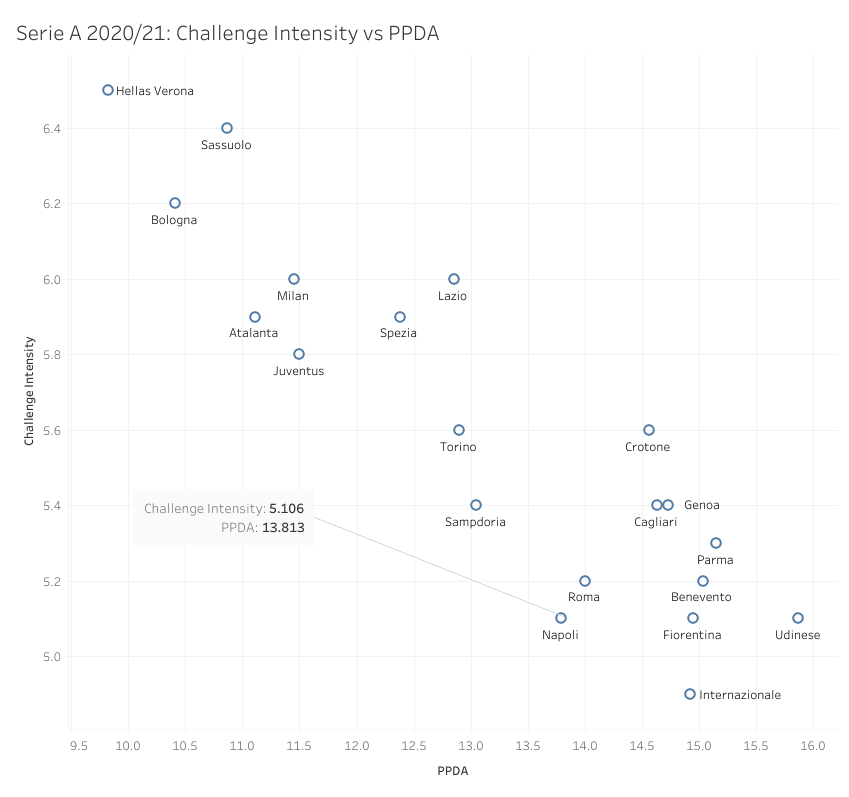
Overall, this shows that Gattuso preferred his team not to go looking to win the ball back immediately or aggressively when the opposition where in possession. Instead, they would look to maintain a solid defensive shape.
When you compare this to how Valencia looked to win the ball back under Jose Bordalas, there is a notable difference. Bordalas liked Valencia to play directly and if possession was lost, win the ball back quickly whilst being in the opposition’s half. If they failed to win the ball back within a certain time and the opposition progressed into a certain area of the pitch, then they would look to retreat into their defensive shape.
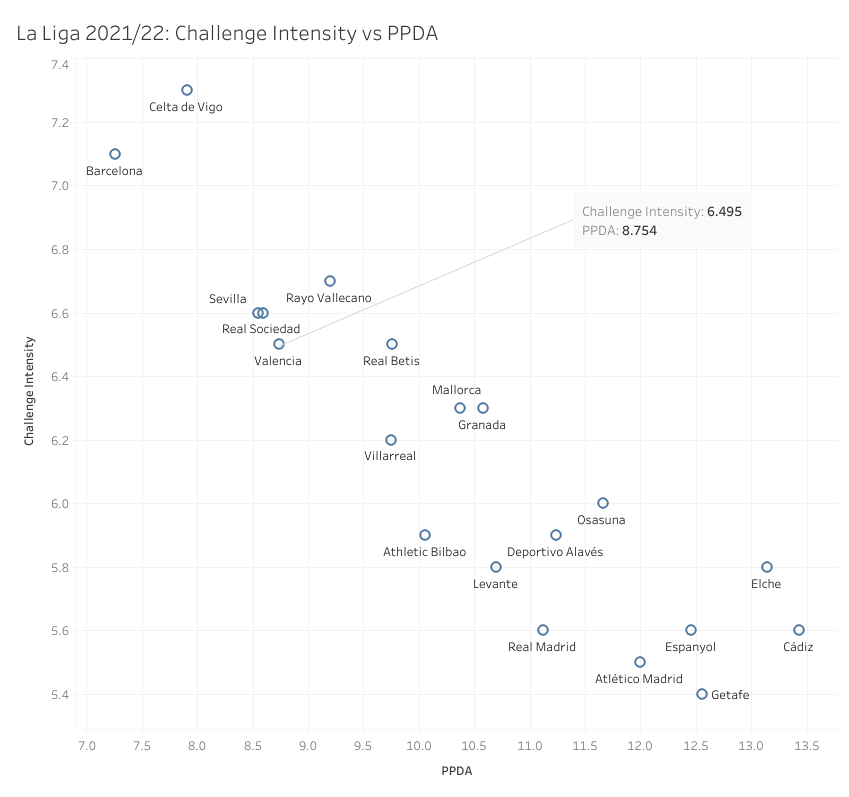
In possession. Gattuso’s Valencia will differ from that of Bordalas’ Valencia. Although Gattuso’s teams are not over-reliant on keeping possession, his teams do generally average a higher amount of possession than Bordalas’ teams. In his full season in charge of Napoli, the team averaged 54.3% possession. As you can see the table shows that Napoli averaged the third-highest amount of possession in Serie A in the 2021/22 season.
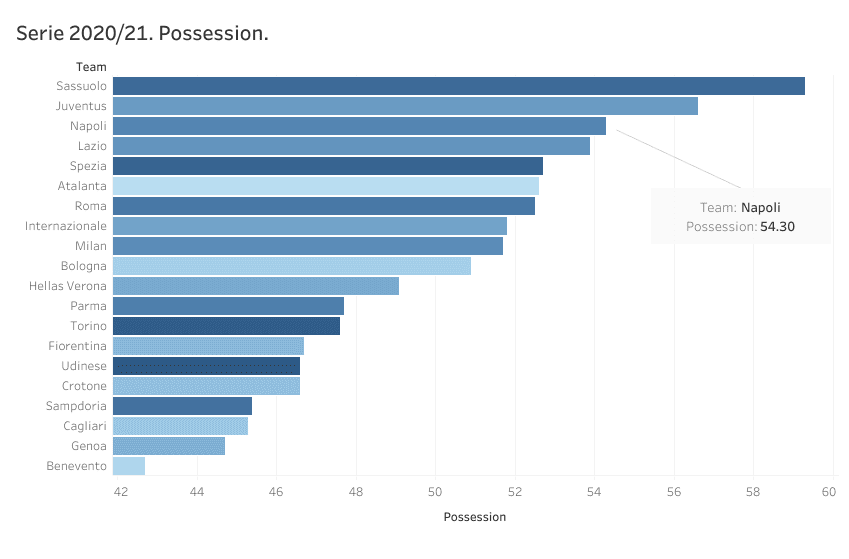
This aspect of Gattuso’s management is what the Valencia fans will appreciate more. Last season Valencia played very direct, they wanted to get the ball from back to front quickly. Tactically they were set up to try to control the games with their manipulation of space rather than their use of the ball. Bordalas didn’t want the team to have the ball in their half of the pitch.
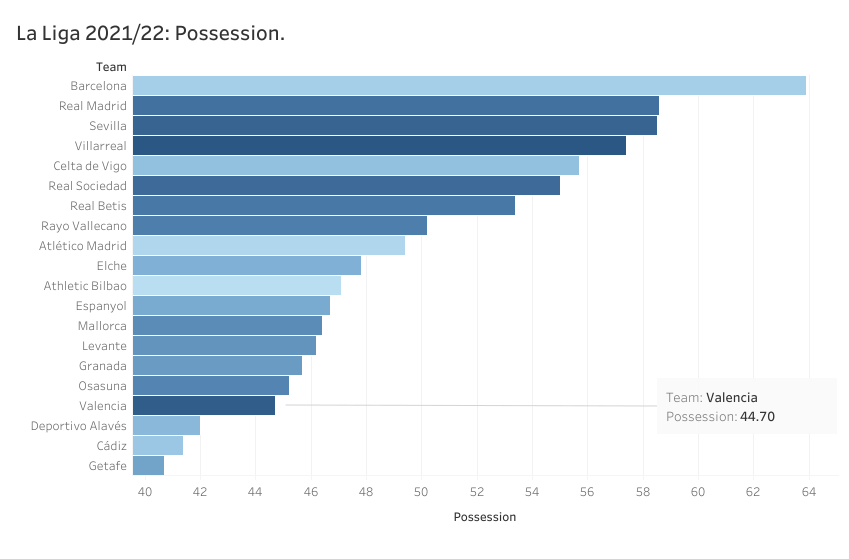
Gattuso will want Valencia to keep the ball more than they did last season. As you can see in the graph above, Valencia only averaged 44.7% possession, which was the fourth-least in La Liga. Gattuso’s attacking approach is completely different to that of the Bordalas. Gattuso likes his teams to play out from the goalkeeper and through the defence.
Build Up
During the build-up phase at Napoli, the centre-backs would often take the goal kicks and play them short to the goalkeeper to get him involved in the play. The idea is that once the goalkeeper becomes involved in the play it attracts the opposition to close him down immediately, which creates gaps for the team to play through. This is a common tactic that was implemented during Gattuso’s time at Napoli. They would retain possession in their defensive third to pull the opposition in and then look to attack the space they leave open whilst trying to win the ball.
The example below shows a standard routine of Napoli’s build-up shape under Gattuso.

His team’s build-up would consist of six players. The fullbacks wouldn’t push high up the pitch to provide a wide outlet, they would sit deep. This is because it created two possibilities. They could be used as a decoy to attract the opposition’s wide players, as shown in the image above, or they can use the fullbacks as part of the build-up to stretch the opposition and build up through the wide areas.
Another vital tactic used by Gattuso at Napoli was having two midfielders drop to the edge of the penalty area. If you look at the image above once the goal kick is taken Napoli have immediately set up a 4v2 overload through the centre of the pitch. Correa and Immobile not only have to stop Napoli’s centre backs progressing with the ball but if they do and press them Napoli’s double pivot is left spare.
The only way the opposition can keep deep in their defensive third was to allow more players to join the play further up the pitch, which is what Napoli wanted.
Balance
As the team progresses further up the pitch, Gattuso prioritises balance as a tactic within his team’s attacking approach. For example, at Napoli he didn’t like both full attacks attacking at the same time, he didn’t want both wide players attacking in the same way. When one wide tucked inside and looked to play in the half-space, the wide player on the opposite would hold the width.
You can see the method being applied here against Udinese. Lorenzo Insigne has tucked inside and plays in the half-space as Hirving Lozano pulls further out wide. This prompts the reserve movement from full-back Giovanni De Lorenzo and pushes insides to play centrally as Piotr Zielinski moves forward and supports Victor Osimhen in the attacking line.
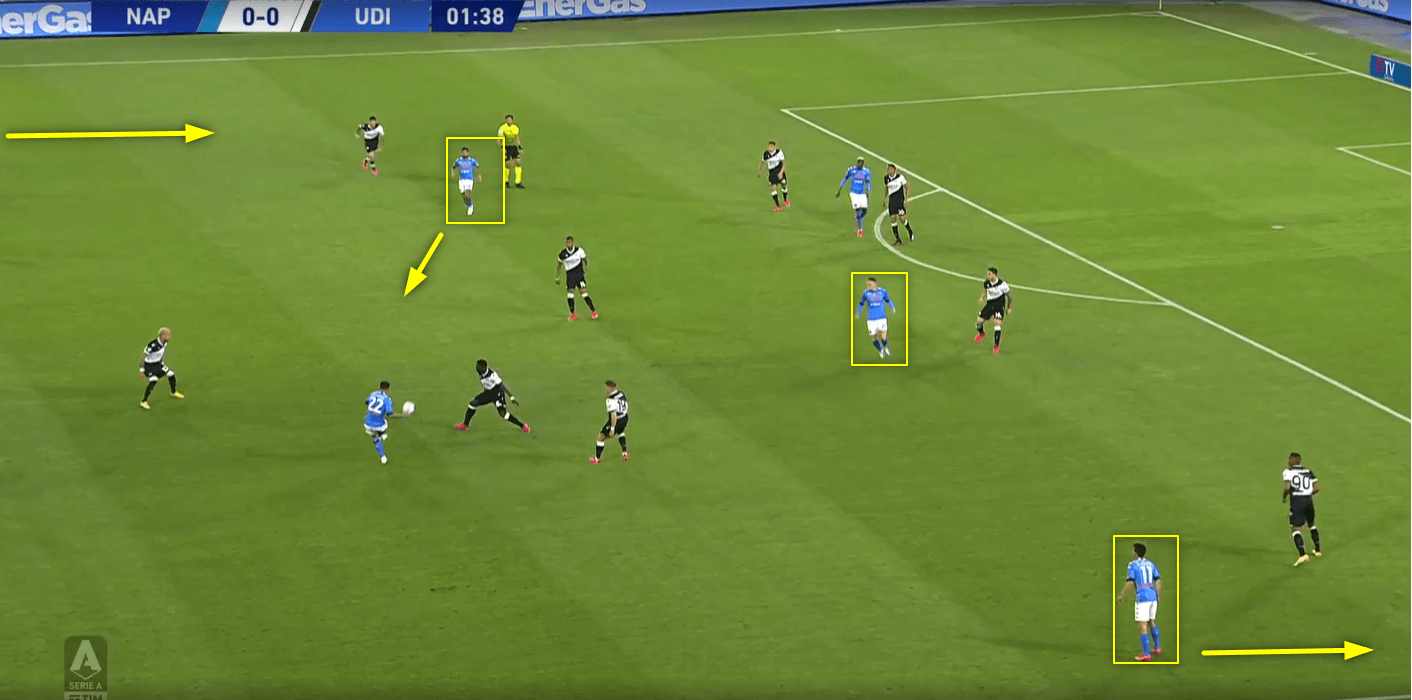
The attacking play of Gattuso’s tactics could be raised as a possible weakness in the Italian’s tactical approach. We’ve already discussed how Napoli under his guidance aimed to keep possession deep in their half, to try and draw the opposition in to press them. This then opens more space to attack. However, once his teams beat the press it feels like Gattuso wants his teams to attack in force and allows the players the freedom to attack how and where they want to, with the only principle being the attacking structure is to remain balanced.
There were times when Napoli became almost too unpredictable. It appeared the team were over-reliant on individuals to produce rather than any kind of coached pattern play to suit a particular strength of the team or weakness of the opposition. Napoli scored 86 goals during Gattuso’s full campaign, their expected goal ratio was 74.73, which was the highest over the performance of XG in Serie A that season. Their expected goal per shot was 0.124, the fifth worse in the league.
Defensive Approach
When his teams are in the defensive phase of play Gennaro Gattuso doesn’t instruct his teams to press aggressively to win the ball back. They look to keep within their defensive shape and maintain a solid defensive structure, making them difficult to play through.
His teams are well-organised and are not accustomed to one specific defensive block. During his time in charge, both Milan and Napoli would defend in high, medium, and low blocks at different stages of a match. The players are individually instructed to close specific spaces in front of the ball carrier to force the play into a certain area. Usually, this area is out wide as Gattuso likes the team to stay compact and protect the middle of the pitch and keep the space between the lines to a minimum.
Gattuso’s preferred formation at Napoli was a 4-2-3-1 formation. When defending this allows the team scope to transition between a 4-1-4-1, 4-5-1 and a 4-4-2 defensive block. This image shows Napoli in a 4-1-4-1 medium block, but the minute the ball gets played to the number 10, Lozano will press the man, Demme will move across towards the right-hand side and then Bakayoko will push forward into the midfield Line creating a 4-4-2 defensive block.
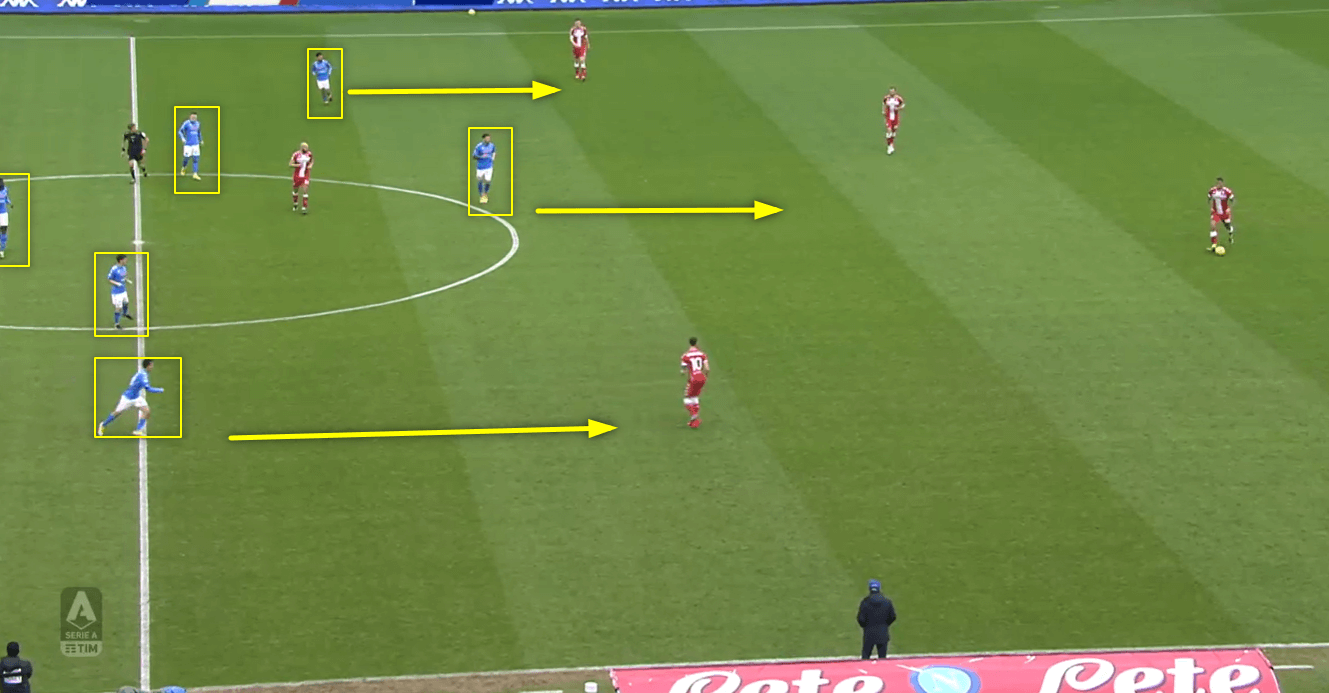
Gattuso preferred a 4-4-2 defensive shape during his time in Naples.
Staggered Shape
When Napoli were defending high up the pitch. Their aim was not to stop the team from playing out from the goalkeeper that’s the approach Napoli invited under Gattuso. The aim was to let the opposition have the ball and play themselves into a mistake, and if the mistake didn’t happen to stop them from being able to play through each third of the pitch. This was implemented through a staggered 4-4-2 defensive shape.
In this feature, you can see how Piotr Zieliński joins Dries Mertens and created the 4-4-2. Napoli are sitting in a narrow shape leaving space in the wide areas, and how AC Milan’s double pivot of Franck Kessie and Sandro Tonali are both closely marked. The position of Napoli’s Zielinski and Mertens can’t be overlooked in this image.

They are not pressing against the ball and have split to encourage Donnarumma, Milan’s goalkeeper, to play the ball into midfield. This would create a 4v2 in Napoli’s favour and put immediate pressure on Kessie and Tonali. The wide position also discourages Milan from playing to the centre-backs as they would be put under immediate pressure. It forces Donnarumma into a long pass out wide to Milan left-back Theo Hernandez, once this happens Napoli move across as a team and presses the ball immediately. This channels the opposition’s build-up down one side.
Look at the image below as Napoli immediately put pressure on Inter as they receive the ball out wide through similar circumstances. The staggered 4-4-2 structure is applied as the team moves across and compresses any space available for Inter to progress. They haven’t got time to switch the play and can’t pass inside because of how quick Napoli have closed the passing options.
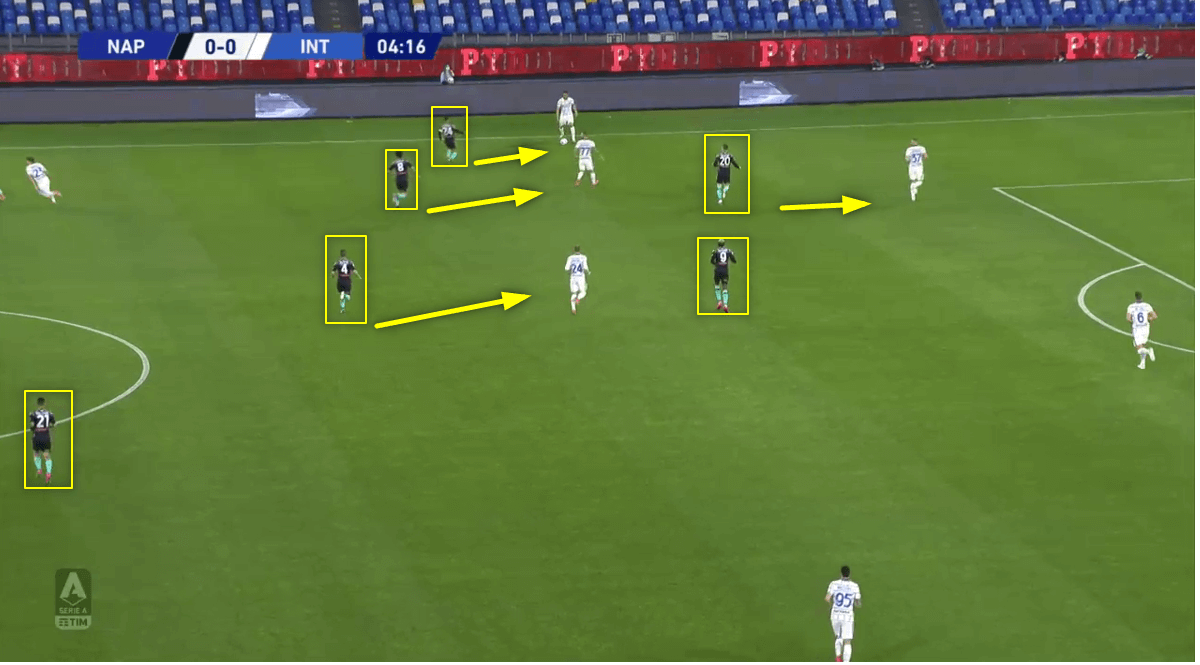
This approach is maintained all over the pitch. Staggered lines can often be mistaken for a team lacking in organisation as it doesn’t look as clear as flat lines. However, a staggered defensive line indicates a positional pressing approach which allows the team more flexibility If the opposition progress past the player pressing, the team can reconfigure their defensive shape. However, the team being compact is essential to this.
Compactness
You can see this when Gattuso’s Napoli faced Andrea Pirlo’s Juventus. Napoli are defending deep in a low block, and the same principles apply: protect the central spaces, limit the space between the lines and channel the play down the flank nearest to the ball carrier, all of which have been applied here. Politano begins to close the space in front of Danilo which leaves him two options, pass quickly to Chiesa to his left who is not ready and has his back to the goal or pass back to centre backs. Juventus are looking to create an overload on the right flank but there is no way of getting the ball across the pitch quickly enough.
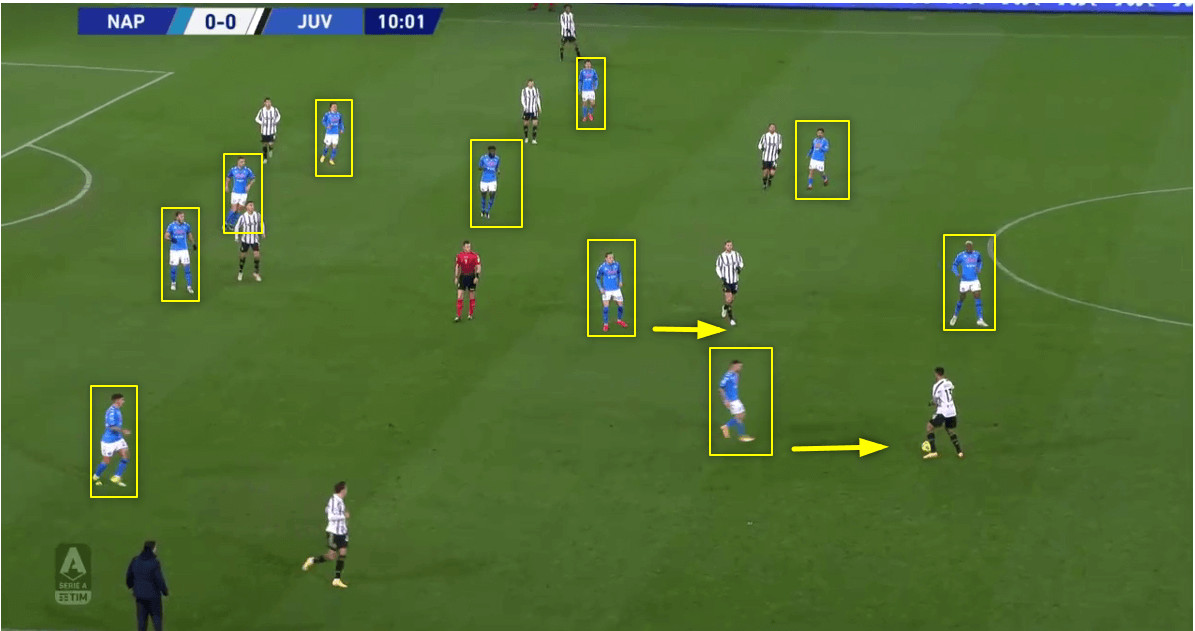
Conclusion
Last season, Valencia finished ninth and reached the Copa del Rey final where they got beat on penalties by Real Betis. So, ending Jose Bordalas’s tenure after just one season in charge makes appointing him in the first place look even more bizarre.
Following that up with the appointment of Gennaro Gattuso shows why the discontent amongst Valencia’s fanbase is not misguided or misplaced. The appointment feels short-sighted by Peter Lim and, once again, the question of whether the club’s ownership is correct and good enough for the club to move forward will remain.
The pressure will be on the former AC Milan man from the start, but if there is one thing you can’t question about Gattuso’s management, its passion and commitment to his job, his willingness to want to win football matches remains in his character from his time as a player.
This analysis has shown different aspects of Gattuso’s tactical approach. We have shown tactical trends in both the attacking and defensive phases of play and provided statistical analysis to show how Gattuso’s time at Valencia might differ from Bordalas’ one season at the club.

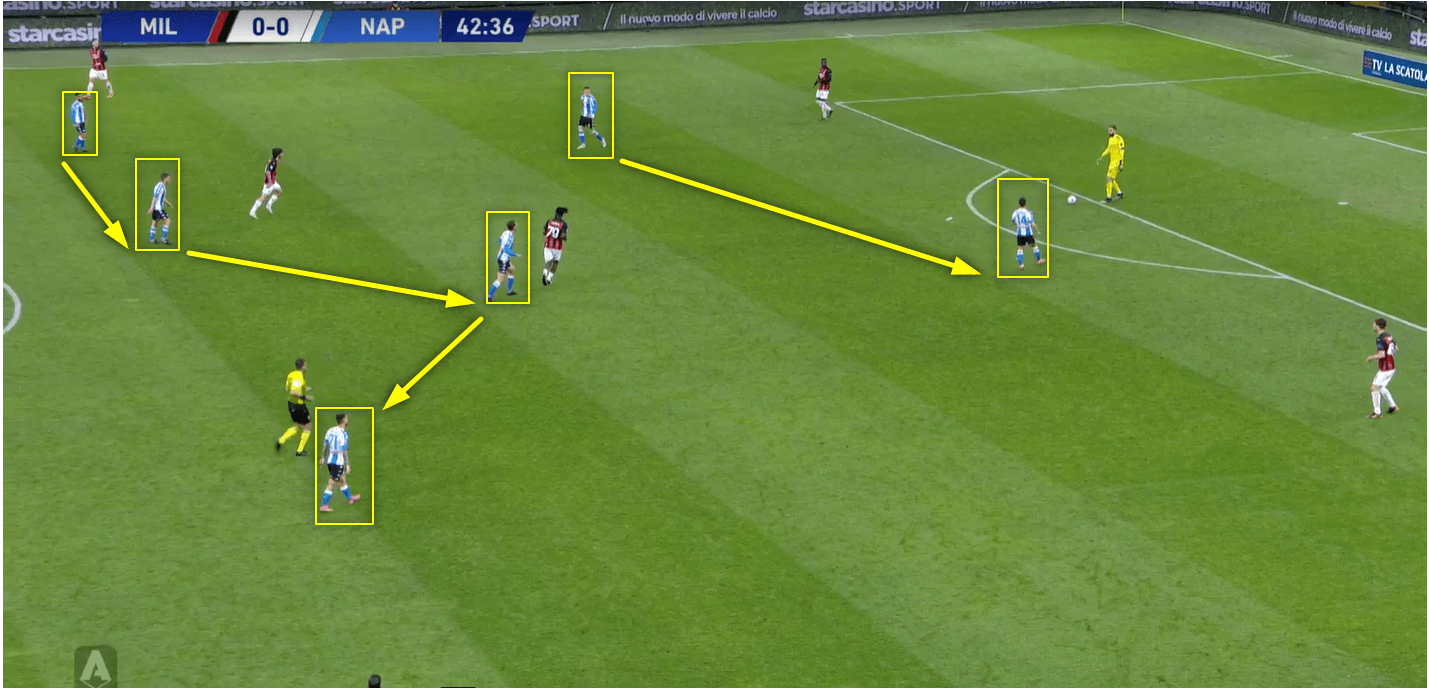




Comments